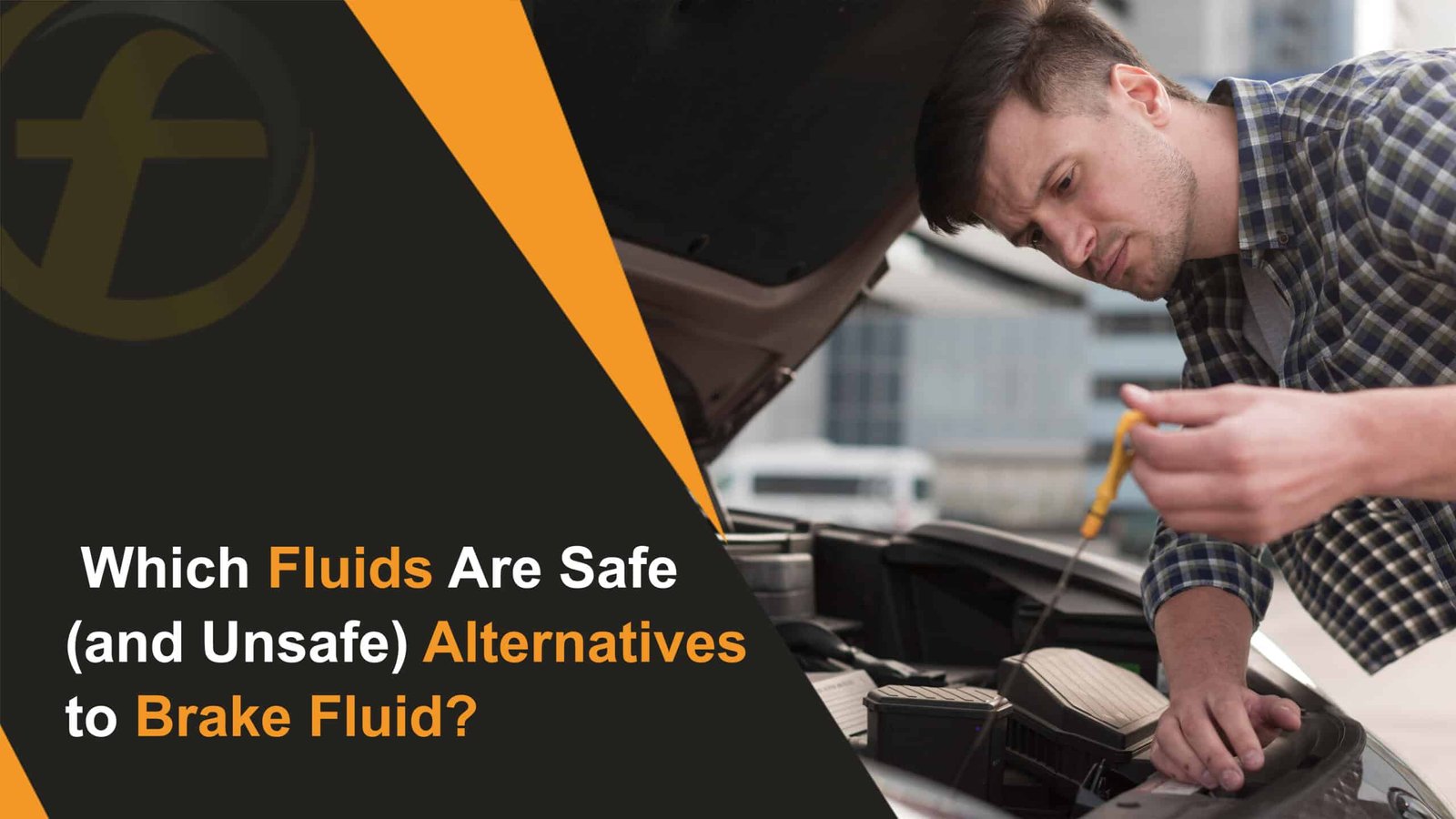
A car owner noticed something unusual while driving — the brake pedal felt spongy and less responsive with every press. Alarmed by the change, they decided to pull over immediately for safety. When they lifted the hood and checked the brake fluid reservoir, they were shocked to find it almost empty.
For a moment, panic set in. Without brake fluid, the braking system can’t build the pressure needed to stop the vehicle properly. The driver began to wonder: What could be done now? Was there any safe substitute that could work temporarily until proper brake fluid was available?
Keep reading to discover the emergency alternatives that might help in such a situation — and why some common household liquids should never be used.
Major Highlights
- Brake fluid is an essential part of a vehicle’s braking system.
- It transfers the force from the brake pedal to the brake pads, enabling the car to slow down or stop.
- Without enough brake fluid, the braking system cannot function properly, creating serious safety risks.
- In rare emergencies, knowing safe substitutes for brake fluid can provide a temporary solution until the correct fluid is available.
Common Brake Fluid Problems and Warning Signs
Brake fluid issues often show up through noticeable symptoms, such as:
- A spongy or soft brake pedal
- Dashboard brake warning light turning on
- Visible brake fluid leaks
- Reduced braking efficiency
- Grinding or squealing sounds when pressing the brakes
If you notice any of these signs, it’s important to act quickly. Timely maintenance not only protects your vehicle but also ensures safety for everyone on the road.
Causes and Key Background Information
Brake fluid is a specialized hydraulic fluid designed to handle extreme heat and pressure inside the braking system. Most brake fluids are either glycol-based (DOT 3, DOT 4) or silicone-based (DOT 5). Using the wrong type can lead to system damage and put safety at risk.
In rare emergencies where brake fluid is not available, certain temporary substitutes may be used until the correct brake fluid is added. While these alternatives may not deliver the same performance, they can serve as a short-term solution in urgent situations.
Common Myths and Misconceptions
Many people believe that any liquid can replace brake fluid in an emergency, but this is a dangerous myth. Using the wrong fluid can severely damage the braking system and even cause complete brake failure, putting lives at risk. Only approved substitutes should ever be considered, and they must be replaced with the correct brake fluid as soon as possible.
| Substitute | Effectiveness | Safety |
| Water | Poor | Unsafe |
| Mineral oil | Fair | Limited |
| Vegetable oil | Poor | Unsafe |
| Transmission fluid | Fair | Limited |
Practical Tips for Emergency Situations
If proper brake fluid is not available, the following guidelines can help when considering temporary substitutes:
- Never use water — it causes corrosion and can severely damage the braking system.
- Mineral oil may work in emergencies, but it should never be relied on long term.
- Avoid vegetable oil — it is not compatible with braking systems and can create serious risks.
- Transmission fluid can serve as a short-term option, but it must be replaced with the correct brake fluid as soon as possible.
- Drive with extra caution when using any substitute to reduce the chance of accidents.
- Visit a professional mechanic promptly to flush out the substitute and restore the system with proper brake fluid.
How to Spot Brake Fluid Problems
Watch out for these warning signs that may indicate issues with your brake fluid:
- A spongy or soft brake pedal with reduced stopping power
- Low or contaminated fluid in the brake fluid reservoir
- Brake warning light glowing on the dashboard
- Leaks or strange noises when pressing the brakes
When to Call a Professional
Seek immediate help from a qualified mechanic if you notice any of the following:
- A strong, lingering odor even after cleaning the braking system
- Loud or unusual noises from brake components
- Water leakage with visible bubbles on brake lines
- A persistent gas-like smell after flushing the system
7 Best Brake Cleaner Substitutes
Brake cleaner is effective, but not always the safest option. Fortunately, there are several alternatives that can clean your brake components without harsh chemicals. Here are seven substitutes worth considering:
1. Baking Soda
Baking soda is a natural, non-toxic cleaner. Mix it with water to form a paste, apply it to a rag, and wipe the brake parts. It removes dirt and grime safely.
2. White Vinegar
White vinegar is a simple, low-maintenance solution. Soak a cloth in vinegar and wrap it around the dirty area. Leave it overnight, and stains should wipe off easily the next day.
3. Lemon Juice
Lemon juice works well as a natural degreaser. Spray it on the dirty surface, wait an hour, then wipe clean with a towel. For stubborn grime, boil the lemon juice to thicken it, then reapply.
4. Alcohol
Rubbing alcohol is another safe option. It removes dirt, grease, and residue effectively. Dampen a rag with alcohol and wipe down the brake components.
5. Dish Soap and Water
A mild dish soap and water mixture is a gentle substitute for brake cleaner. Apply it with a towel, scrub lightly, then rinse thoroughly with clean water.
6. Acetone
Acetone is a strong solvent that effectively removes grease, oil, and brake fluid. While powerful, it is a safer option compared to gasoline-based cleaners. Use it with caution.
7. Turpentine
Turpentine is a natural oil that works as a solvent. It can clean brake parts, but safety precautions are necessary — always wear gloves and eye protection, as it may irritate skin or eyes.
Final Takeaways
Understanding which substitutes can be used for brake fluid in emergencies is vital for preventing accidents and protecting lives. While temporary options may help in urgent situations, they are not a long-term solution. Always replace them with the correct brake fluid as soon as possible.
If you notice any problems with your braking system, consult a professional mechanic right away to avoid further damage and maintain maximum safety. Stay safe on the road by staying prepared and keeping up with your vehicle’s maintenance needs.
FAQs
Q1: What fluid is compatible with brake fluid?
No fluid is truly compatible with DOT-type brake fluid in cars, as substitutes can damage the system and cause brake failure. In rare emergencies, low-speed setups like bicycles may use temporary options such as dish soap with water or mineral oil, but they are unsafe for long-term use.
Q2: What should you do if you have no brake fluid?
If your brake fluid is completely empty, do not drive — it can lead to total brake failure and put your life at risk. If the level is just low, refill it immediately with the correct brake fluid and have the system checked by a professional to prevent further damage.
Q3: Can you just refill brake fluid if it’s empty?
Yes, you can top up brake fluid without removing the old fluid, as long as the system hasn’t been exposed to air. However, if moisture has entered the system, bleeding the brakes becomes necessary to restore safe performance.

Editor-at-Large
A passionate writer in the lubricant industry, Awais Iqbal has been covering oils, greases, and industrial fluids since the start of his career. At 25, he’s already written for blogs, catalogs, and brand guides across the UAE. Awais’s insights help companies connect with their audience, and his clear, helpful writing style is trusted by brands in the region.


